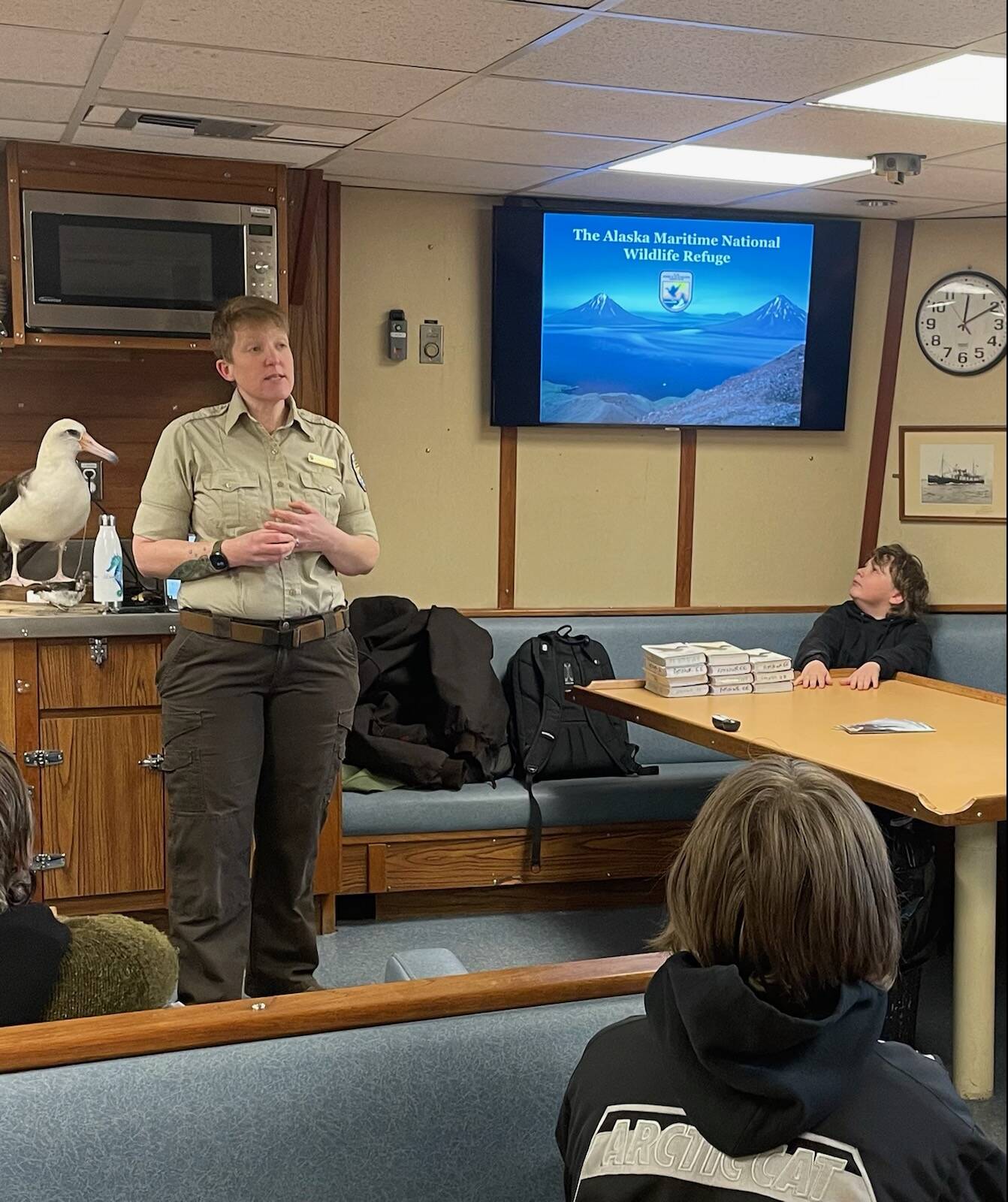Homer’s Fireweed academy students had the opportunity last week to tour the R/V Tiglax, a research and transportation support vessel used by the Alaska Maritime National Wildlife Refuge.
The refuge stretches from the volcanic islands of the Aleutian chain to the Inside Passage, and north to the Chukchi Sea — providing essential habitat for marine mammals and millions of seabirds, representing more than 30 species, according to the refuge information pamphlet and presentation provided to students on the tour.
The Tiglax also serves as the transport vessel for sample collections on the Seward line for the northern Gulf of Alaska long-term ecological research with University of Alaska Fairbanks researchers.
On Thursday, April 6, 18 students, Fireweed teacher Carly Garay and volunteers met in the galley for an introduction to the Alaska Maritime National Wildlife Refuge, a brief lesson on habitat protection and what the purpose of the research vessel is.
Refuge Education Specialist Kendra Bush explained to students the important role the vessel plays in protecting the marine habitat, noting that the Tiglax runs about six months every year and stays in the Homer Harbor in the winter. The refuge is accessible to researchers only by water so the vessel is critical transportation and laboratory space.
“It usually travels 18,000 miles every season,” Bush said.
Students split into groups for a vessel tour to see how the different parts of the ship operate. Captain John Faris began his portion of the tour in the storage section of the boat with a lesson on the importance of a life jacket and survival suit.
“What’s the first thing you do when you get on a boat? Put on a life jacket!” he said. “Because how long do you last in the water without a life jacket?”
In three or four minutes, he told students, “you start getting cold and your muscles stop working and your clothes might make you too heavy to swim.”
He explained the material, neoprene, used to construct survival suits, the various features they include and why it’s important to know how to put one on.
“Do you feel that? It’s like putting on a layer of blubber,” he told students.
“I put these on once month all summer long. We jump in the water and train with them all the time. You need to be able to put it on in less than a minute, because if there’s an emergency you might not have a lot of time,” he said.
He also explained the whistle, strobe and belt features of a survival suit.
Volunteer chaperone Tim Scheffel asked if the Tiglax has encountered many emergency situations.
“There have been a few things over the 35 years,” Faris said. “She’s had her bumps and bruises but we haven’t lost anybody and we haven’t lost the boat.”
He also pointed out exercise options on the ship: a bicycle, rowing machine, jump rope and weights and other exercise equipment.
From the storage area the tour group ascended to the top house and Captain Faris explained that when it’s rough out, the higher up you get on the boat there is more motion and the more uncomfortable it is.
“That’s why keep the scientists down below,” he said.
He explained the crew positions of the boat and what their roles are: mate, deckhands, cook and engineer.
The group moved on to the wheelhouse and discussed the activities that take place there: steering station, rudder controls and alternate stations.
“As you can see here, we have redundancy in everything,” Faris said. “In case something is broken, we have another way to make something work because where we travel out in the western Aleutians there are very few other boats. It’s usually just us and a couple big boats.”
Faris also showed students how to use a marine chart, and how to use a sounder device and the equipment necessary to find latitude and longitude. His final lesson for the wheelhouse was on how radar works.
“The radars spin with an electronic radar from the top of the boat and send out a pulse; when they find something solid it makes a picture on this screen here,” he said, pointing to a screen.
He explained how to change the distance on the screen to see images, land or other vessels that are farther out and why the intensity of the image changes depending on what the radar picks up.
In the final parts of the boat tour, Student Conservation Association representative Marisa Hayward showed the marine wet and dry lab stations of the boat and talked about the kind of material collected and surveyed from the ship: kelp, jelly fish, seabird and marine mammals.
For more information on the Alaska Maritime National Wildlife Refuge visit the Islands and Oceans Visitor Center in Homer or www.alaskamaritime.fws.gov.


